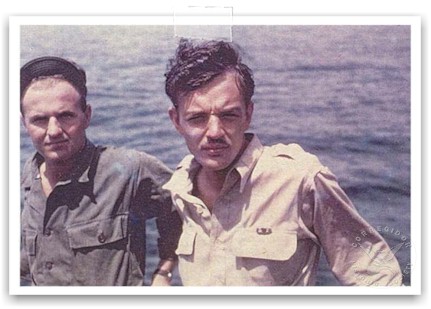|
The number of trucks to transport the RCT was limited. The 1st and 2nd
Battalions were on Topside along with the artillery, Regimental
Headquarters and Service Companies, and others. Note the early hour of
2nd Battalion Headquarters and Headquarters Company, then D Company
followed at 0730. I don't believe F company left Topside until after
noon. I do remember we rode down. I remember we were very interested in
seeing Bottomside, because we had not been there. We had lined the road
at Middleside to guard MacArthur's route to Topside. I know we went over
to the North Dock area, then to the Officers Beach where we looked some
suicide boats over. Then we looked at the East Entrance to Malinta
Tunnel. I remember there were many rusty 03 Springfield barrels
and parts along with splintered stocks which our troops had destroyed
before surrendering.
As I remember-all too soon it was time to load and shove off at 1700
hour.
Evidently during this time the LCI's were moving in, loading and sailing
out into
the North Channel. As I remember only one or two other LCI's were
loading as we loaded, so this must have been staggered.
The thing which drew our great interest, though, while we were looking
around was
the Japanese "Shinyo" (suicide) boats. Some of these boats had attacked
our fleet when it moved in on Corregidor before the assault. An LCM
gunboat had been sunk. Had a amphibious
assault been the sole attack, these boats would have played a larger
part most likely.
The boats I saw had old Buick automobile motors powering them. Before
the war, people in the United States well well aware that the Japs were
buying old cars from junk yards across the entire country. I remember
hearing some old, wise heads saying that we'd be getting that steel
fired back at us someday. But this is like Demosthenes futile efforts to
rouse the Athenian's... no arms - just live for the day, or as Neville
Chamberlain said, "Peace in our time."
The boats demonstrate the type of people we were fighting. There was no
way the operator could escape death.
The explosives were stored in front of the boats. A sheet of galvanized
steel curved around the inside of the bow. About six inches inside this
sheet was another galvanized sheet, nails were driven through the outer
sheet with their sharp ends pointed toward the
inner parallel sheet. A battery was wire to the sheets so that if
contact was made between
the two sheet the electric circuit was completed detonating the
explosive. Thus any crushing of the bow of the boat by as much as six
inches set off the large explosive charge.
National archives photo number
111-SC-263697 shows three of these "Shinyo" boats at Officers
Beach.
In spite of poor intelligence and the resulting mismanagement, the
airborne landing was a brilliant success. This was a classic example of
using the parachute assault to its
maximum effectiveness. The superior training, aggressiveness, and
toughness of the troopers
overcame the errors and mistakes. For the most part we were happy, and
relived, to be leaving this dusty mass of wreckage where death lurked at
every turn. Possibly just as great an emotion was intense pride; we had
retaken our great fortress marking this event forever as the high water
mark of our lives, or at the least ranking with the high water marks.
Memories were indelibly burned in our minds for so long as we shall
live. Yet not all was joy. We were leaving behind some forty-nine
battalion brothers who would never grow old. Even after forty-five years
the grief is still there. Another thought which survives the years is
the haunting question, why them and not me?
At 1700 hour the LCI's began their departure. The little ships (they
were bigger than boats) formed a long line of single file and set a
course for Mindoro. Even though there were fewer ships than would have
been required to transport the RCT, our ships
were not crowded as they usually were with a full compliment of
soldiers, an Infantry company.
Corregidor gradually faded in the distance - from sight- from our minds,
nevermore.
The winds rose with the coming of dark, and the seas became wild. The
LCI's seemed
to stand on one end and then the other. To doze meant to be thrown out
of your bunk onto
the unyielding steel deck. Most of us tried various means of tying
ourselves onto the bunks with out web equipment.
At dawn most of us were up inspecting our surroundings. Some were
hanging onto the
railings, heads over the side desperately trying to throw up when there
was nothing left
to throw up. The galley was particularly noisy. The galley was manned by
one cook who
prepared meals for the crew. The passengers had to bring their own field
rations aboard.
In this instance the ship's cook seemed to be the sickest of all,
hanging on the chains at the fantail. I don't think he really cared if
he hung on or not- a fall into the deep might bring on the peace of Davy
Jones's Locker and end all this misery. A look into the galley disclosed
the source of the noise. A large frying pan with associated utensils was
bouncing from wall to wall. Raw eggs had hit the walls and run down to
the floor. Evidently the cook held on long enough to get several eggs
into the pan ready to cook when he was overcome, dropped everything and
headed for the fantail. The old salts
were not happy with this land-lubber who had yet to gain his sea legs.
They were hungry.
|
![]()
![]()
